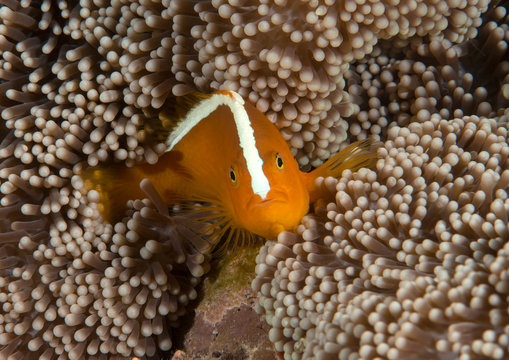ANIMAL: Orange Skunk Clownfish Amphiprion sandaracinos Type of Animal: Clownfish Habitat: Outer reef slopes/coral reefs/lagoons not deeper than 66 ft around anemone/coral hosts Location(s): Indo-Pacific from Ryukyu Islands to N Australia & Christmas Island Appearance: Somewhat stocky-bodied fish w/ oval shape & laterally compressed, bright to pale orange w/ white stripe along dorsal ridge, females larger than males Food/Diet: Algae, zooplankton, rotifers, crustaceans, polychaete worms, anemone leftovers, nori Status in Wild: Stable Conservation: Breeding in aquariums, aquaculture, & zoos Lifestyle: All clownfish born as males w/ most dominant clownfish becoming female. Colony ranges from 1 monogamous pair to monogamous pair w/ juveniles/subordinate males. When female dies, her mate becomes female & next male in hierarchy or new male becomes breeding partner. Juveniles sometimes found alone. Dominance determined by size. Additional Info: Called: Male Female Young: Fry Group: Colony Weight: Male: 0.02 oz Female: 0.05 oz Gestation: 9-11 days Life Span: 3-10 years Body Length: Male: 1.2-2.6 in Female: 4.4 in Also called Orange Anemonefish, Skunk-Striped Clownfish, & Skunk-Striped Anemonefish. Like other clownfish/anemonefish, well-known for mutualistic relationships w/ anemones. Sea anemone protects clownfish from predators as well as providing food through scraps left from anemone’s meal. In return, clownfish defend anemone fiercely from intruding clownfish/predators. Unlike many clownfish, they can thrive w/o host anemone & utilize coral host if anemone not available. Maturity determined more by size than age. Spawning occurs during full moon. Clownfish only take anemones not filled by other clownfish. Females release anything from 100-1,000 eggs (average of 300). Dominant pair monitor feeding of subordinates very closely making sure they don’t grow too large. Sometimes hybridize w/ much larger Orange-Fin Anemonefish off N coast of New Guinea producing hybrid known as White Bonnet Anemonefish. These clownfish are much shier than many other species. Have been observed sharing anemones w/ other clownfish species. Majority of these fish in aquariums wild-caught. Eggs deposited on flat surfaces w/ both parents defending eggs. After eggs hatch, larval period lasts 10 days. Not as common in captivity as some other clownfish species. They spawn multiple times a year. Fun Fact(s): While highly territorial, these clownfish not nearly as aggressive as some other species. Females & dominant males produce chirps & pops while charging/chasing subordinates. Get skunk clownfish name due to white stripe.
